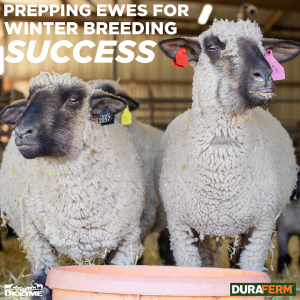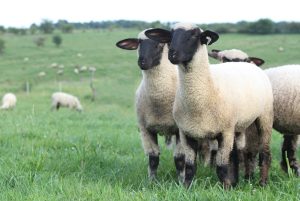
Sheep and goats are natural grazers. In most areas grass and other forages are abundant, yet need managed, which is best done naturally through proper grazing. Land stewardship is really an example of “care that comes full circle,” as humans and animals take care of the land, while it provides feed and nutrients to the animals.
As the temperatures warm and vegetation starts to come out of dormancy, it is time to consider turning sheep and goats out to summer pastures. There are several considerations to make before and during grazing. Whit Stewart, Ph.D., University of Wyoming Assistant Professor and Extension Sheep Specialist for the state of Wyoming, offers his advice on pasture management and best management practices for grazing sheep and goats. His first piece of advice is to remember that every region is different, even within a state, and he suggests seeking local advice for specific questions.
“There’s so much diversity in the sheep industry in our country. I do think that identifying mentors in the sheep industry or in your local sheep industry is really important, because yes, we have the resources at the University and Extension and USDA, but nothing can beat the hard-earned knowledge that producers gain and give to one another,” he said.
Pasture Management
Small ruminants like sheep and goats vary from cattle in the types of forages they prefer. They will eat the shorter forbs or shrub-like plants before they eat the taller grasses. Sheep will go for the most nutritious parts of the plants first, the leaves and anything that is soft before they eat the stems or even grass. Stewart said that having a variety of plant species and putting your sheep and goats out when those plants are in the vegetative stage instead of a more mature stage is the best option to receive optimum nutrients from the forages. It is essential to have forages that are high in digestible fiber and at high enough levels of crude protein to keep their rumens functioning properly.
“The other important thing is having some legumes in your pasture. Where we have irrigated pastures in the West that support some sheep but probably in more temperate climates moving toward the Midwest you have the ability to have a little bit more consistent precip so that you can introduce some legumes, clovers, those kinds of plants to keep the nitrogen levels up for the crude protein requirements, as well as enhancing the digestibility,” Stewart said.
Part of the key to proper pasture management is a combination of stocking rate and determining how intensively you plan to graze. Since each geographic region is so diverse, there is no one-size-fits-all stocking rate. One thing to keep in mind is that sheep will consume about 3% of their body weight in dry matter intake daily. Stewart said in the more lush, green areas you can possibly graze five to 10 sheep or goats per acre, whereas in the drier climates it might take five acres to run just one small animal. However, he does recommend a tool from the NRCS that he uses in a class to help determine stocking rate and grazing capacity.
The Web Soil Survey is a free interactive tool that can pull up soil data for your specific area. The data shares how productive your vegetation is, and the software serves as a good resource for determining a baseline for what a good, average and below average year would produce in terms of forage for a grazing allotment, according to Stewart.
Once you know how many animals you can run on your allotted space, you need to decide if you will practice intensive grazing or more of rotational grazing. Intensive grazing allows the group of sheep and goats to eat forages from a larger area for a longer period. Remember, they will eat the most nutritious parts of the plants first. It will also take longer for the vegetation to grown back. Rotational grazing puts the animals in a smaller area for a shorter time – usually about every five days.
The type of grazing situation you utilize will often dictate the kind of fencing that is best for your flock or herd. The ideal material for a perimeter fence is woven wire fence. Another way to keep sheep and goats within their perimeter is to add one or two wires of electric fence. For those wanting to practice more rotational grazing, you will need an electric fence or an electro-net fence, which is a roll-up fence that is electronically charged. It is high enough to keep sheep in and predators out.
“Sheep are pretty responsive as long as your fence is hot,” Stewart said to dispel the myth that sheep will not respect an electric fence.
Best Management Practices
Once you have determined your stocking rate, grazing method and have your pasture fenced properly to contain your sheep or goats, it is important to consider keeping them comfortable and healthy. Water is the most essential nutrient for any animal, and your small ruminants are no exception. However, Stewart did say that early in the spring and again in the fall, they might not drink as much water as we think they should because they are getting hydration from the plants they are consuming.
“The water content of the forages in the early spring and early fall is 80 to 90% so sometimes we fill up the water trough and we don’t see sheep drinking, but the dietary water content is an important consideration,” he said.
Ewes and does do require plenty of clean, fresh water daily. Since they are flocking animals, water should be in a large tank that allows several animals to drink at once. Remember, their water requirements are higher during hot temperatures and lactation than during the less humid, cooler temperatures or after they have weaned their offspring.
Another consideration for grazing, especially in the heat and humidity is shade. Be sure to have some where your animals can go to cool off in the heat of the day to get out of the sun. Trees, buildings with ventilation and man-made shade like wind breaks or temporary shade are all options.
Keeping your sheep and goats healthy is an investment you can’t afford to skimp on. Stewart said one of the biggest concerns with grazing is the Barber Pole Worm that thrives in humid, wet, low growing grasses. He said a deworming regimen along with allowing sufficient rest in between grazing pastures is vital to make sure the life cycle of the Barber Pole Worm is exhausted – usually 30 to 40 days.
“This internal parasite is probably one of the greatest animal health challenges that we have, especially as we move closer to the Mississippi River. One of the best management practices that we’re preaching now is making sure that dewormer that you use is still working,” Stewart said.
As if internal parasites weren’t enough, anyone who has raised sheep know the threats that predators pose. Fortunately, there are multiple options to deal with predator challenges like a variety of guardian animals or night penning. Night penning is more effective in areas where you are grazing smaller flocks and have the facilities. Guardian animals add another level of management to your operation.
“Guardian animals, whether they be llamas, donkeys or dogs, and each of those options has varying degrees of effectiveness and time that is put into them, and it’s like any management tool on a sheep enterprise your predator management tool is not necessarily foolproof. For example, dogs have their personalities, keeping them with the sheep, making sure you get guard dogs that have come from working stock and they’re well bonded to the sheep and not wanting to just be a pet. That’s something that we work with a lot out here in the West, for those clients who are looking at more of a farm flock type grazing scenario, a donkey or a llama are probably a little bit more conducive if you’ve got neighbors close by or you’re just not sure if your dog is well trained enough,” Stewart said.
One management practice that Stewart recommends from a resource management and an economic benefit is multi-species grazing, if a person has both small ruminants and cattle. He said it makes sense to graze both cattle and sheep since both prefer different forages, with the cattle consuming the more fibrous feed like the taller grasses that the sheep don’t really like. Conversely, the sheep and goats will go after the shrubs, forbs and weeds. He said that it is often a misconception that the fencing has to be completely overhauled for sheep and goats if fences are set up for cattle. That is simply not true, and often time a few strands of electric fence will help contain the sheep and goats.
Nutrition Matters
Even though forages are an efficient means of providing digestible nutrients to your sheep and goats, Stewart said additional supplementation should not be overlooked. This is especially true if you are unsure of nutrient content of your soils and plants and as the plants peak at maturity and start to loose their nutritional benefits.
“There’s a major decline in the macro and micro minerals in most cool and warm season grasses, as the season progresses. I think having a mineral out and monitoring consumption is a best management practice anyways, but especially as we get into the fall and we consider getting ready for breeding. The mineral content is just much less than it was in the early part of the growing season,” he said.
One way to supplement your flock or herd is with the DuraFerm® mineral program. DuraFerm offers three sheep minerals and two goat minerals that are designed to provide the balanced levels of high-quality vitamin and minerals required for growth, breeding and parturition. All DuraFerm minerals contain Amaferm®, a precision-based prebiotic that impacts intake, feed digestibility and nutrient absorption for amplified breeding performance, high levels of Vitamin E for reproductive tract repair and 2.5 times NRC for quicker impact. Wise pasture management, best management practices and good nutritional supplements make grazing your sheep flock or goat herd an economically efficient means to take of both the land resources while providing your animals good forage resources, just one example of care that comes full circle.

